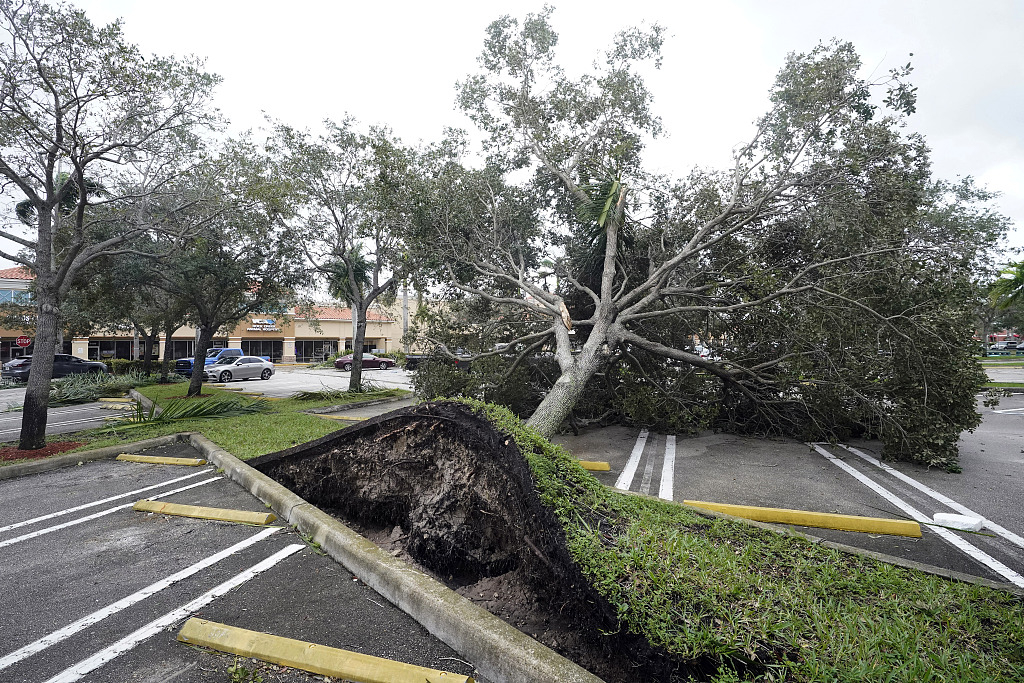The polluted leftovers of Florida's phosphate fertilizer mining industry, more than 1 billion tonnes in "stacks" that resemble enormous ponds, are at risk for leaks or other contamination when Hurricane Ian comes ashore in the state, environmental groups say.
Florida has 24 such phosphogypsum stacks, most of them concentrated in mining areas in the central part of the state. About 30 million tonnes of this slightly radioactive waste is generated every year, according to the Florida Industrial and Phosphate Research Institute.
"A major storm event like the one we are bracing for can inundate the facilities with more water than the open-air ponds can handle," Ragan Whitlock, staff attorney for the Center for Biological Diversity environmental group, said in an email Tuesday.
"We are extremely concerned about the potential impacts Hurricane Ian may have on phosphate facilities around the state," Whitlock added.
A leak in March 2021 at a stack called Piney Point resulted in the release of an estimated 215 million gallons of polluted water into Tampa Bay and caused massive fish kills. State officials, overseen by a court-appointed receiver, are working with a $100 million appropriation to shut down that long-troubled location.
"During the past six months, the receiver has made significant progress toward closing the facility," lawyers for Governor Ron DeSantis said in a court filing Monday.
But the Center for Biological Diversity, which sued with other groups to close down Piney Point, noted that 4.5 million additional gallons of wastewater were released into Tampa Bay in August.
"The imminent and substantial endangerment to the environment and human health and safety posed by Piney Point has not been abated" since a judge ordered a six-month stay in the case.
Hurricane Ian made its landfall on Florida's southwest coast on Wednesday as a dangerous Category 4 storm. It was expected to cut through the state – very close to many of the gypsum stacks.

An uprooted tree, toppled by strong winds from the outer bands of Hurricane Ian, rests in a parking lot of a shopping center in Cooper City, Florida, September 28, 2022. /VCG
An uprooted tree, toppled by strong winds from the outer bands of Hurricane Ian, rests in a parking lot of a shopping center in Cooper City, Florida, September 28, 2022. /VCG

Motorists travel across the John Ringling Causeway as Hurricane Ian churns to the south in Sarasota, Florida, September 28, 2022. /VCG
Motorists travel across the John Ringling Causeway as Hurricane Ian churns to the south in Sarasota, Florida, September 28, 2022. /VCG
State Department of Environmental Protection records show that Piney Point has about 24 inches (60 centimeters) of rainfall capacity. Another facility in the Tampa Bay area, operated by phosphate giant Mosaic Co., has just over 9 inches (22 centimeters) of rainfall capacity.
A spill could seriously damage rivers and other wetlands near the stacks, according to Jim Tatum of the Our Santa Fe River nonprofit group.
"Valuable aquatic and vegetative resources never fully recover from a spill," Tatum wrote on the organization's website. "As the highly acidic, radioactive slime makes its way to the receiving waters, entire aquatic ecosystems are impacted."
A spokeswoman for Mosaic said the company carefully plans for storm season each year and has been preparing its worksites in Florida for Hurricane Ian.
"At this point, we have taken the appropriate steps to protect our people, mines, plants, port facilities and administrative offices," spokeswoman Jackie Barron said in an email. "We continue monitoring weather updates while completing preparations at our phosphate mining and production facilities."
Phosphate has been mined in Florida since 1883. It's used mainly for fertilizer to produce food, animal supplements and a variety of industrial products. Land used in mining is required to be "reclaimed," or brought as close as possible back to its original state.
The byproducts that wind up in the stacks, however, have few uses acceptable to federal regulators. They can contain radioactive uranium, thorium and radium along with toxic metals such as barium, cadmium and lead, according to the environmental group ManaSota 88.
Fertilizers are made from phosphate rock that contains naturally occurring uranium and thorium, which decay to radium, and radium decays to the radioactive gas radon, the Environmental Protection Agency says. Class-action lawsuits have claimed health effects for people living near the mining waste.
"Phosphate companies have had over 70 years to figure out a way to dispose of radioactive gypsum wastes in an acceptable manner, but they have yet to do so," said Glenn Compton, chairman of ManaSota 88.
(All images via VCG)
(If you want to contribute and have specific expertise, please contact us at nature@cgtn.com)
Source(s): AP

